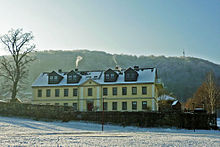Wilhelminenschacht
| Wilhelminenschacht | |||
|---|---|---|---|
| General information about the mine | |||
| Mining technology | Longwall mining | ||
| Funding / total | 905,431 t | ||
| Information about the mining company | |||
| Operating company | Baron von Burgker coal and ironworks | ||
| Start of operation | 1815 | ||
| End of operation | 1918 | ||
| Funded raw materials | |||
| Degradation of | Hard coal | ||
| Mightiness | 5.50 m | ||
| Greatest depth | 207 m | ||
| Geographical location | |||
| Coordinates | 51 ° 0 '7.1 " N , 13 ° 39' 52.8" E | ||
|
|||
| Location | Burgk | ||
| local community | Freital | ||
| District ( NUTS3 ) | Saxon Switzerland-Eastern Ore Mountains. | ||
| country | Free State of Saxony | ||
| Country | Germany | ||
The Wilhelminenschacht was a coal mine of the Baron von Burgker Steinkohlen- und Eisenhüttenwerke . The shaft was located in the central part of the hard coal deposit of the Döhlen Basin in the so-called Lower Revier in Burgk . The preserved miner's house and the machine house for the drainage are under state protection as a cultural monument .
history
The Barons von Burgker Steinkohlen- und Eisenhüttenwerke started digging the shaft in 1815 . The at 213 m above sea level. The shaft set up above sea level reached a depth of 207 meters. From 167 meters the first seam with a thickness of 5.50 meters was cut. The second seam penetrated at 180 meters was 0.80 meters, the third seam penetrated at 188 meters was 0.60 meters and the fourth seam penetrated at 193 meters was 0.20 meters. With the cross passage set at a depth of 202 meters, 4 small jumps of the southern branch of the Becker shaft fault were crossed in a south-easterly direction at a distance of 147 to 360 meters . The seam here was raised by 3 meters, 7 meters, 3 meters and 5 meters. The seam, which otherwise dipped south, was on the same level.
The daily route Unteres Revier served as a journey for the team . The drainage of the mine field took place via a wing of the Burgker Weißeritz tunnel .
Between 1823 and 1830 a hand-operated set wash was built. It was the first wet scrubbing in the German coal industry. Two beehive ovens were used for coke production from 1823. From 1840 the first coke oven in Saxony was supplied to the König-Friedrich-August-Hütte in Dölzschen . Between 1842 and 1847, the coal from the Neuhoffnungsschacht on Windberg, which was delivered via its Rösche , was also processed.
A gas generation plant was built in 1828 for public lighting in Burgk and for their own purposes. It was the second such facility on the European continent. The gasworks achieved its highest output in 1899 with 46,122 m 3 of coal gas .
In 1858, a miner was killed in a firedamp explosion .
After depletion of inventories has been promoting adjusted to the 1870th The total output over the operating time was 905,431 tons. The shaft was still used for dewatering. In 1893 the dewatering was temporarily stopped. In 1904, an electric triplex pump (piston pump) from the company JE Näher from Chemnitz was installed to obtain water for the coal washing underground. In 1915 the shaft was dropped. In 1918, the Burgker Weißeritz tunnel wing in the shaft was dammed and the shaft filled. After the daytime facilities were demolished, only the miner's house and the machine house of the steam engine remained. The buildings are used for residential purposes.
1977 the Wilhelminenschacht kept safe by the Bergsicherung Dresden .
Erdmannschacht
From 1820 to 1822, the Erdmannschacht (steam engine shaft) was sunk 40 meters west of the Wilhelminenschacht as a central auxiliary shaft for dewatering in the Lower Revier . The at 210 m above sea level. The shaft set up above sea level reached a depth of 122 meters. It was named after the Prussian mountain Anton Friedrich Erdmann from Wettin , who was employed as a technical adviser at the Burgker Works. A steam engine was planned to drive the pumps, as had already proven itself at the Zauckerode Royal Coal Works . The low-pressure condensation machine with balancer was supplied by the Kinne company in Halle / Saale in 1822 and had an output of 8 hp. Another steam engine with 16 hp was used from 1838 as a drive for the rope conveyance on the Wilhelminenschacht in addition to the dewatering. It was made by the Baron von Burgk'schen Eisenhüttenwerk. The Erdmannschacht was dropped again as early as 1845–46 .
In 1972 the Erdmannschacht was kept safe by the Dresden Mountain Security.
literature
- Eberhard Gürtler, Klaus Gürtler: The hard coal mining in the Döhlen basin part 1 - shafts to the right of the Weißeritz , house of the homeland Freital, 1983
- Hermann Credner: Explanations of the special geological map of the Kingdom of Saxony , Royal Finance Ministry, Leipzig, 1892
- Yearbook for mining and metallurgy in the Kingdom of Saxony from 1873 to 1918


